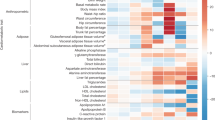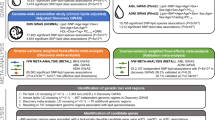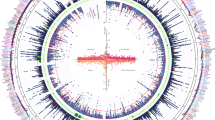Abstract
To evaluate the shared genetic etiology of type 2 diabetes (T2D) and coronary heart disease (CHD), we conducted a genome-wide, multi-ancestry study of genetic variation for both diseases in up to 265,678 subjects for T2D and 260,365 subjects for CHD. We identify 16 previously unreported loci for T2D and 1 locus for CHD, including a new T2D association at a missense variant in HLA-DRB5 (odds ratio (OR) = 1.29). We show that genetically mediated increase in T2D risk also confers higher CHD risk. Joint T2D–CHD analysis identified eight variants—two of which are coding—where T2D and CHD associations appear to colocalize, including a new joint T2D–CHD association at the CCDC92 locus that also replicated for T2D. The variants associated with both outcomes implicate new pathways as well as targets of existing drugs, including icosapent ethyl and adipocyte fatty-acid-binding protein.
This is a preview of subscription content, access via your institution
Access options
Access Nature and 54 other Nature Portfolio journals
Get Nature+, our best-value online-access subscription
$29.99 / 30 days
cancel any time
Subscribe to this journal
Receive 12 print issues and online access
$209.00 per year
only $17.42 per issue
Buy this article
- Purchase on Springer Link
- Instant access to full article PDF
Prices may be subject to local taxes which are calculated during checkout

Similar content being viewed by others
References
Guariguata, L. et al. Global estimates of diabetes prevalence for 2013 and projections for 2035. Diabetes Res. Clin. Pract. 103, 137–149 (2014).
Xu, J., Murphy, S.L., Kochanek, K.D. & Bastian, B.A. Deaths: final data for 2013. Natl. Vital Stat. Rep. 64, 1–119 (2016).
Rao Kondapally Seshasai, S. et al. Diabetes mellitus, fasting glucose, and risk of cause-specific death. N. Engl. J. Med. 364, 829–841 (2011).
Scott, R.A. et al. A genomic approach to therapeutic target validation identifies a glucose-lowering GLP1R variant protective for coronary heart disease. Sci. Transl. Med. 8, 341ra76 (2016).
Morris, A.P. et al. Large-scale association analysis provides insights into the genetic architecture and pathophysiology of type 2 diabetes. Nat. Genet. 44, 981–990 (2012).
Nikpay, M. et al. A comprehensive 1000 Genomes–based genome-wide association meta-analysis of coronary artery disease. Nat. Genet. 47, 1121–1130 (2015).
Bulik-Sullivan, B. et al. An atlas of genetic correlations across human diseases and traits. Nat. Genet. 47, 1236–1241 (2015).
Jansen, H. et al. Genetic variants primarily associated with type 2 diabetes are related to coronary artery disease risk. Atherosclerosis 241, 419–426 (2015).
Mahajan, A. et al. Genome-wide trans-ancestry meta-analysis provides insight into the genetic architecture of type 2 diabetes susceptibility. Nat. Genet. 46, 234–244 (2014).
GTEx Consortium. The Genotype-Tissue Expression (GTEx) pilot analysis: multitissue gene regulation in humans. Science 348, 648–660 (2015).
Grundberg, E. et al. Mapping cis- and trans-regulatory effects across multiple tissues in twins. Nat. Genet. 44, 1084–1089 (2012).
Huyghe, J.R. et al. Exome array analysis identifies new loci and low-frequency variants influencing insulin processing and secretion. Nat. Genet. 45, 197–201 (2013).
Saleheen, D. et al. The Pakistan Risk of Myocardial Infarction Study: a resource for the study of genetic, lifestyle and other determinants of myocardial infarction in South Asia. Eur. J. Epidemiol. 24, 329–338 (2009).
Smith, G.D. & Ebrahim, S. 'Mendelian randomization': can genetic epidemiology contribute to understanding environmental determinants of disease? Int. J. Epidemiol. 32, 1–22 (2003).
Ross, S. et al. Mendelian randomization analysis supports the causal role of dysglycaemia and diabetes in the risk of coronary artery disease. Eur. Heart J. 36, 1454–1462 (2015).
Ahmad, O.S. et al. A Mendelian randomization study of the effect of type-2 diabetes on coronary heart disease. Nat. Commun. 6, 7060 (2015).
Willer, C.J. et al. Discovery and refinement of loci associated with lipid levels. Nat. Genet. 45, 1274–1283 (2013).
Shungin, D. et al. New genetic loci link adipose and insulin biology to body fat distribution. Nature 518, 187–196 (2015).
Raychaudhuri, S. et al. Identifying relationships among genomic disease regions: predicting genes at pathogenic SNP associations and rare deletions. PLoS Genet. 5, e1000534 (2009).
Rossin, E.J. et al. Proteins encoded in genomic regions associated with immune-mediated disease physically interact and suggest underlying biology. PLoS Genet. 7, e1001273 (2011).
Wang, J., Duncan, D., Shi, Z. & Zhang, B. WEB-based GEne SeT AnaLysis Toolkit (WebGestalt): update 2013. Nucleic Acids Res. 41, W77–W83 (2013).
de Pontual, L. et al. Germline deletion of the miR-17∼92 cluster causes skeletal and growth defects in humans. Nat. Genet. 43, 1026–1030 (2011).
Kuro-o, M. et al. Mutation of the mouse klotho gene leads to a syndrome resembling ageing. Nature 390, 45–51 (1997).
O'Connor, L. et al. Bim: a novel member of the Bcl-2 family that promotes apoptosis. EMBO J. 17, 384–395 (1998).
Suzuki, M. et al. Plasma FGF21 concentrations, adipose fibroblast growth factor receptor-1 and β-klotho expression decrease with fasting in northern elephant seals. Gen. Comp. Endocrinol. 216, 86–89 (2015).
Grimbert, P. et al. Truncation of C-mip (Tc-mip), a new proximal signaling protein, induces c-maf Th2 transcription factor and cytoskeleton reorganization. J. Exp. Med. 198, 797–807 (2003).
Madsen, L.S. et al. A humanized model for multiple sclerosis using HLA-DR2 and a human T-cell receptor. Nat. Genet. 23, 343–347 (1999).
Barrett, J.C. et al. Genome-wide association study and meta-analysis find that over 40 loci affect risk of type 1 diabetes. Nat. Genet. 41, 703–707 (2009).
Sattar, N. et al. Statins and risk of incident diabetes: a collaborative meta-analysis of randomised statin trials. Lancet 375, 735–742 (2010).
Swerdlow, D.I. et al. HMG–coenzyme A reductase inhibition, type 2 diabetes, and bodyweight: evidence from genetic analysis and randomised trials. Lancet 385, 351–361 (2015).
White, J. et al. Association of lipid fractions with risks for coronary artery disease and diabetes. JAMA Cardiol. 1, 692–699 (2016).
Fall, T. et al. Using genetic variants to assess the relationship between circulating lipids and type 2 diabetes. Diabetes 64, 2676–2684 (2015).
Schmidt, A.F. et al. PCSK9 genetic variants and risk of type 2 diabetes: a mendelian randomisation study. Lancet Diabetes Endocrinol. 5, 97–105 (2017).
Law, V. et al. DrugBank 4.0: shedding new light on drug metabolism. Nucleic Acids Res. 42, D1091–D1097 (2014).
Ballantyne, C.M. et al. Efficacy and safety of eicosapentaenoic acid ethyl ester (AMR101) therapy in statin-treated patients with persistent high triglycerides (from the ANCHOR study). Am. J. Cardiol. 110, 984–992 (2012).
Ballantyne, C.M. et al. Effects of icosapent ethyl on lipoprotein particle concentration and size in statin-treated patients with persistent high triglycerides (the ANCHOR Study). J. Clin. Lipidol. 9, 377–383 (2015).
Boord, J.B. et al. Adipocyte fatty acid–binding protein, aP2, alters late atherosclerotic lesion formation in severe hypercholesterolemia. Arterioscler. Thromb. Vasc. Biol. 22, 1686–1691 (2002).
Hotamisligil, G.S. et al. Uncoupling of obesity from insulin resistance through a targeted mutation in aP2, the adipocyte fatty acid binding protein. Science 274, 1377–1379 (1996).
Makowski, L. et al. Lack of macrophage fatty-acid-binding protein aP2 protects mice deficient in apolipoprotein E against atherosclerosis. Nat. Med. 7, 699–705 (2001).
Furuhashi, M. et al. Treatment of diabetes and atherosclerosis by inhibiting fatty-acid-binding protein aP2. Nature 447, 959–965 (2007).
Burak, M.F. et al. Development of a therapeutic monoclonal antibody that targets secreted fatty acid-binding protein aP2 to treat type 2 diabetes. Sci. Transl. Med. 7, 319ra205 (2015).
Scott, R.A. et al. An expanded genome-wide association study of type 2 diabetes in Europeans. Diabeteshttp://dx.doi.org/10.2337/db16-1253 (2017).
Auton, A. et al. A global reference for human genetic variation. Nature 526, 68–74 (2015).
Howie, B.N., Donnelly, P. & Marchini, J. A flexible and accurate genotype imputation method for the next generation of genome-wide association studies. PLoS Genet. 5, e1000529 (2009).
Willer, C.J., Li, Y. & Abecasis, G.R. METAL: fast and efficient meta-analysis of genomewide association scans. Bioinformatics 26, 2190–2191 (2010).
Feng, S., Liu, D., Zhan, X., Wing, M.K. & Abecasis, G.R. RAREMETAL: fast and powerful meta-analysis for rare variants. Bioinformatics 30, 2828–2829 (2014).
Liu, D.J. et al. Meta-analysis of gene-level tests for rare variant association. Nat. Genet. 46, 200–204 (2014).
Dastani, Z. et al. Novel loci for adiponectin levels and their influence on type 2 diabetes and metabolic traits: a multi-ethnic meta-analysis of 45,891 individuals. PLoS Genet. 8, e1002607 (2012).
Evans, D.M. & Davey Smith, G. Mendelian randomization: new applications in the coming age of hypothesis-free causality. Annu. Rev. Genomics Hum. Genet. 16, 327–350 (2015).
Welter, D. et al. The NHGRI GWAS Catalog, a curated resource of SNP–trait associations. Nucleic Acids Res. 42, D1001–D1006 (2014).
Purcell, S. et al. PLINK: a tool set for whole-genome association and population-based linkage analyses. Am. J. Hum. Genet. 81, 559–575 (2007).
Yang, J. et al. Conditional and joint multiple-SNP analysis of GWAS summary statistics identifies additional variants influencing complex traits. Nat. Genet. 44, 369–375 (2012).
Doria, A., Patti, M.E. & Kahn, C.R. The emerging genetic architecture of type 2 diabetes. Cell Metab. 8, 186–200 (2008).
Benjamini, Y. & Hochberg, Y. Controlling the false discovery rate: a practical and powerful approach to multiple testing. J. R. Stat. Soc. B 57, 289–300 (1995).
Acknowledgements
D.S. has received support from NHLBI, NINDS, Pfizer, Regeneron Pharmaceuticals, Genentech, and Eli Lilly. Genotyping in PROMIS was funded by the Wellcome Trust, UK, and Pfizer. Biomarker assays in PROMIS have been funded through grants awarded by the NIH (RC2HL101834 and RC1TW008485) and Fogarty International (RC1TW008485). The RACE study has been funded by NINDS (R21NS064908), Fogarty International (R21NS064908), and the Center for Non-Communicable Diseases (Karachi, Pakistan). B.F.V. was supported by funding from the American Heart Association (13SDG14330006), the W.W. Smith Charitable Trust (H1201), and the NIH/NIDDK (R01DK101478). J.D. is a British Heart Foundation Professor, European Research Council Senior Investigator, and NIHR Senior Investigator. V.S. was supported by the Finnish Foundation for Cardiovascular Research. S. Ripatti was supported by the Academy of Finland (251217 and 255847), the Center of Excellence in Complex Disease Genetics, the European Union's Seventh Framework Programme projects ENGAGE (201413) and BioSHaRE (261433), the Finnish Foundation for Cardiovascular Research, Biocentrum Helsinki, and the Sigrid Juselius Foundation. The Mount Sinai IPM Biobank Program is supported by the Andrea and Charles Bronfman Philanthropies. S. Anand is supported by grants from the Canada Research Chair in Ethnic Diversity and CVD and from the Heart and Stroke Michael G. DeGroote Chair in Population Health, McMaster University. Data contributed by Biobank Japan were partly supported by a grant from the Leading Project of the Ministry of Education, Culture, Sports, Science and Technology, Japan. We thank the participants and staff of the Copenhagen Ischemic Heart Disease Study and the Copenhagen General Population Study for their important contributions. The CHD Exome+ Consortium was funded by the UK Medical Research Council (G0800270), the British Heart Foundation (SP/09/002), the UK NIHR Cambridge Biomedical Research Centre, the European Research Council (268834), the European Commission's Framework Programme 7 (HEALTH-F2-2012-279233), Merck, and Pfizer. PROSPER has received funding from the European Union's Seventh Framework Programme (FP7/2007-2013) under grant agreement HEALTH-F2-2009-223004.
Author information
Authors and Affiliations
Consortia
Contributions
A.R., B.F.V., B.G.N., D.J.R., D.S., D.S.A., J.I.R., M.R., O.M., P.F., R.C., R.J.F.L., S. Anand, S.E., S.M., S. Ripatti, T.-D.W., W.H.-H.S., and W. Zhao conceived of and designed the experiments. A.I., A.M., A.R., A.S.B., B.F.V., B.G.N., B.R.S., C.A.H., D.J.R., D.K.S., D.S., D.S.A., E.P.B., E.S.T., E.T., F.M., F.-u.-R.M., G.P., I.-T.L., I.H.Q., J.-J.L., J.C.C., J.I.R., J.M.M.H., J.S.K., J.W.J., J.Z.K., K.-W.L., K.D.T., K.M., K.T., M.B., N.M., M.O.-M., N.A., N.H.M., S.N.H.R., N.Q., N. Sattar, O.M., P.C., P.F., P.S., R.-H.C., R.C., R.F.-S., R.J.F.L., S. Abbas, S. Anand, S.E., S.J., S.M., S.N.H.R., S. Ralhan, S. Ripatti, S.Z.R., T.-D.W., T.-u.S., T.K., T.L.A., T.S., T.Y., U.M., W.H.-H.S., W.I., W. Zhang, W. Zhao, X.G., Y.-D.I.C., Y.-J.H., Y.L., Y.Y.T., and Z.Y. performed the experiments. A.R., A.S.B., B.F.V., C.A.H., D.S., E.D.A., E.P.B., E.T., I.-T.L., J.-J.L., J.-M.J.J., J.C.C., J.D., J.M.M.H., J.S.K., J.W.J., J.Z.K., K.-W.L., K.D.T., M.B., M.I., M.O.-M., M.R., N.K.M., N. Sattar, N. Shah, O.M., P.C., P.F., P.R.K., P.S., R.-H.C., R.C., R.F.-S., R.J.F.L., R.S., R.Y., S. Anand, S. Asma, S.D., S.F.N., S.M., S. Ralhan, T.-D.W., N.M., T.L.A., T.Q., T.S., T.Y., U.M., V.S., W.-J.L., W.H.-H.S., W. Zhang, W. Zhao, X.G., Y.-D.I.C., Y.-J.H., Y.L., and Y.Y.T. performed statistical analyses. A.I., A.R., A.S., A.S.B., A.T.-H., B.F.V., B.R.S., C.-C.H., C.A.H., D.K.S., D.S., E.D.A., E.P.B., E.S.T., E.T., F.M., G.P., I.-T.L., J.-J.L., J.-M.J.J., J.C.C., J.D., J.I.R., J.S.K., J.Z.K., K.-W.L., K.D.T., K.T., M.I., M.O.-M., M.R., N.H.M., N.Q., N. Sattar, N. Shah, O.M., P.C., P.R.K., P.S., R.-H.C., R.F.-S., R.J.F.L., R.S., R.Y., S. Abbas, S. Asma, S.D., S.J., S. Ralhan, T.K., T.L.A., T.Q., T.S., T.Y., U.M., V.S., W.-J.L., W. Zhao, X.G., Y.-D.I.C., Y.-J.H., Y.L., Y.Y.T., and Z.Y. analyzed the data. A.M., A.S., A.T.-H., B.F.V., B.G.N., D.J.R., D.S., F.u.R.M., G.P., I.H.Q., J.-M.J.J., J.D., J.W.J., N.M., K.M., M.B., M.R., N.A., P.R.K., R.S., S.E., S.N.H.R., S. Ripatti, S.Z.R., T.-u.-S., V.S., W.I., and W. Zhao contributed-reagents, materials, and/or analysis tools. A.R., A.S.B., B.F.V., D.J.R., D.K.S., D.S., E.T., G.P., J.-J.L., J.D., J.I.R., J.M.M.H., M.R., N. Sattar, V.S., and W. Zhao wrote the manuscript. D.S. and B.F.V. led the writing group. W. Zhao, A.R., E.T., B.F.V., and D.S. were equal contributors. B.F.V. and D.S. jointly supervised all aspects of the work.
Corresponding authors
Ethics declarations
Competing interests
The authors declare competing financial interests from their affiliations with Pfizer, Regeneron Pharmaceuticals, Genenetech, and Eli Lilly.
Supplementary information
Supplementary Text and Figures
Supplementary Note and Supplementary Figures 1–9. (PDF 4295 kb)
Supplementary Tables 1–19
Supplementary Tables 1–19. (XLSX 324 kb)
Rights and permissions
About this article
Cite this article
Zhao, W., Rasheed, A., Tikkanen, E. et al. Identification of new susceptibility loci for type 2 diabetes and shared etiological pathways with coronary heart disease. Nat Genet 49, 1450–1457 (2017). https://doi.org/10.1038/ng.3943
Received:
Accepted:
Published:
Issue Date:
DOI: https://doi.org/10.1038/ng.3943



